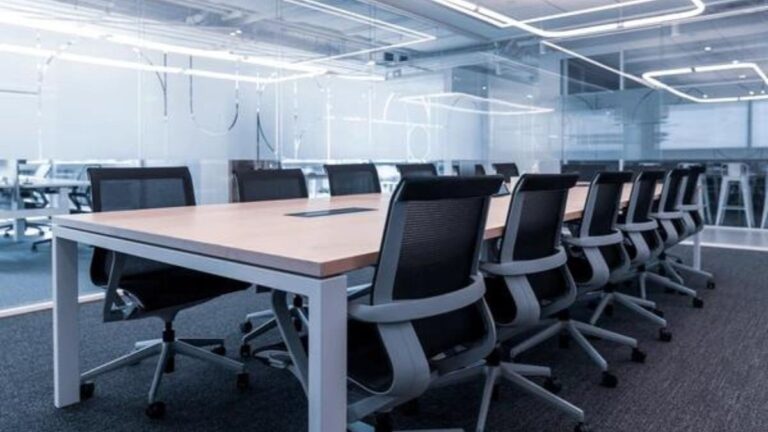In today’s fast-paced corporate environment, the design and functionality of office furniture play a pivotal role in shaping workplace dynamics. Among the various pieces of office furniture, office tables, especially in meeting rooms, serve a significant purpose. They not only provide a space for collaboration but also influence how effectively teams can engage, brainstorm, and make decisions. This blog explores the various ways office tables enhance meeting room efficiency, from layout and design to fostering creativity and promoting productivity.
The Impact of Table Design on Collaboration
The design of office tables directly affects the interaction and communication between team members. A well-designed table can facilitate open dialogue, encourage participation, and create a more inclusive atmosphere. For instance, round tables can break down hierarchical barriers, allowing everyone to feel equal and valued. This is crucial in a meeting setting where diverse opinions and ideas need to be shared freely.
In contrast, long rectangular tables might create a sense of distance among participants, potentially stifling creativity and limiting contributions from those seated farther away from the table’s focal point. Therefore, the choice of table shape and size should align with the meeting’s purpose. For example, a round or oval table might be more suitable for brainstorming sessions, while a rectangular table may work better for formal presentations.
Versatility and Flexibility
Office tables that offer versatility can significantly enhance meeting room efficiency. Modular tables, which can be easily rearranged or reconfigured, allow organizations to adapt the meeting space to various activities. Whether it’s a brainstorming session, a training workshop, or a strategic planning meeting, the ability to change the table layout quickly can accommodate different group sizes and interaction styles.
Moreover, tables equipped with built-in technology—such as power outlets, HDMI ports, and wireless charging stations—facilitate seamless presentations and collaborative work. This technology integration is vital in ensuring that meetings run smoothly and that participants can engage with digital content without unnecessary interruptions.
Promoting Comfort and Focus
Comfort is a crucial factor that contributes to meeting efficiency. Office tables that are ergonomically designed help create a conducive environment for long meetings. Adjustable-height tables, for example, allow participants to alternate between sitting and standing, reducing fatigue and enhancing focus.
Additionally, tables that incorporate features like privacy panels or sound-dampening materials can help minimize distractions. These elements are especially important in open office layouts where noise can be a significant barrier to productive meetings. By creating a more comfortable and focused environment, office tables contribute to more effective discussions and better decision-making.
Supporting Collaboration Through Technology
In the age of remote work and hybrid teams, the role of technology in meetings cannot be overstated. Office tables designed with technology integration in mind can significantly enhance the collaborative experience. For instance, tables with integrated video conferencing systems enable remote participants to engage fully, making virtual meetings feel more personal and interactive.
Moreover, collaborative software tools that can be accessed directly from the meeting table promote real-time idea sharing and documentation. This technology not only streamlines communication but also ensures that all contributions are captured and easily referenced later. Thus, incorporating technological elements into office tables not only enhances efficiency but also empowers teams to leverage digital tools effectively.
Aesthetic Appeal and Professionalism
The aesthetics of office tables also contribute to the overall impression of the meeting space. A well-designed table that reflects the company’s brand can enhance professionalism and create a positive atmosphere for meetings. A visually appealing environment encourages participants to engage more actively and feel proud to represent their organization.
Choosing the right materials and finishes for office tables can also impact the mood of the room. For example, natural wood finishes can create a warm and inviting space, while sleek, modern designs might inspire creativity and innovation. Ultimately, the visual appeal of office furniture, including tables, can play a significant role in setting the tone for productive meetings.
Encouraging Inclusivity and Participation
Inclusivity is a vital aspect of effective meetings. Office tables that are designed to accommodate a diverse range of participants promote an environment where everyone feels comfortable contributing. For example, tables with ample space for wheelchair accessibility ensure that all team members can participate without barriers.
Moreover, tables that allow for collaborative seating arrangements—such as smaller clusters within a larger meeting room—can encourage quieter members to share their thoughts without feeling overwhelmed by a large group. By fostering inclusivity, office tables enhance the overall efficiency of meetings, ensuring that diverse perspectives are heard and valued.
Optimizing Space Utilization
Efficient use of space in meeting rooms is crucial for organizations aiming to maximize productivity. Office tables that are designed to fit seamlessly into the layout of a meeting room can optimize space utilization. For instance, foldable or collapsible tables can be stored away when not in use, allowing for more flexible use of the meeting space for other purposes.
Additionally, tables that can be easily moved around encourage teams to think creatively about how they arrange their meetings. This flexibility allows for a more dynamic environment, where space can be adapted to meet the needs of various teams and activities, thus enhancing overall meeting room efficiency.
The role of office tables in enhancing meeting room efficiency cannot be overlooked. From promoting collaboration and comfort to integrating technology and aesthetics, well-designed tables are essential for fostering productive meetings. As organizations continue to prioritize effective teamwork and communication, investing in the right office furniture, particularly office tables, will remain a critical factor in driving success in the workplace. By understanding and leveraging the various aspects of office tables, businesses can create environments that enhance engagement, creativity, and overall meeting effectiveness.
